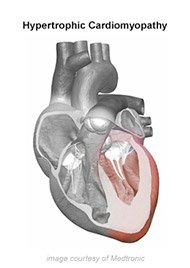HYPERTROPHIC (HCM)

Hypertrophic cardiomyopathy (HCM) is the second most common form affecting about 40 to 50 percent of children with cardiomyopathy. Hypertrophic cardiomyopathy can also occur with obstruction (HOCM). HCM can affect either gender and occur at any age. According to the Pediatric Cardiomyopathy Registry, the average age of diagnosis is 7 years, and one third are diagnosed as infants (before age 1).
HCM refers to an abnormal growth and arrangement of muscle fibers in the heart (myocardial disarray), which thickens the heart walls. Excessive thickening of the heart muscle makes the heart chambers stiffer and smaller, which affects the flow of blood in and out of the heart. Eventually, this may lead to an obstruction of blood flow, making it difficult for the heart to relax and for blood to fill the heart chambers.
Children with HCM have an increased risk for arrhythmias and sudden cardiac arrest. HCM is classified by where the heart walls have thickened:
- Asymmetric septal hypertrophy: thickening is in the left ventricle and septum separating the heart's chambers
- Symmetric ventricular hypertrophy: thickening is evenly distributed throughout the ventricle, septum, and wall
- Apical hypertrophy: thickening occurs in the bottom portion of the heart
In advanced cases, the disease may progress to a form of dilated cardiomyopathy.
In the majority of cases, HCM is familial or inherited. It is commonly found in more than one family member and across generations. HCM can also occur secondary to another genetic diseases. These include metabolic disorders, malformation syndromes, neuromuscular disorders, and glycogen-storage disorders. With metabolic disorders, there is a problem with how the body breaks down food substances to generate energy for the heart. With mitochondrial disorders, the heart’s ability to utilize energy is diminished
